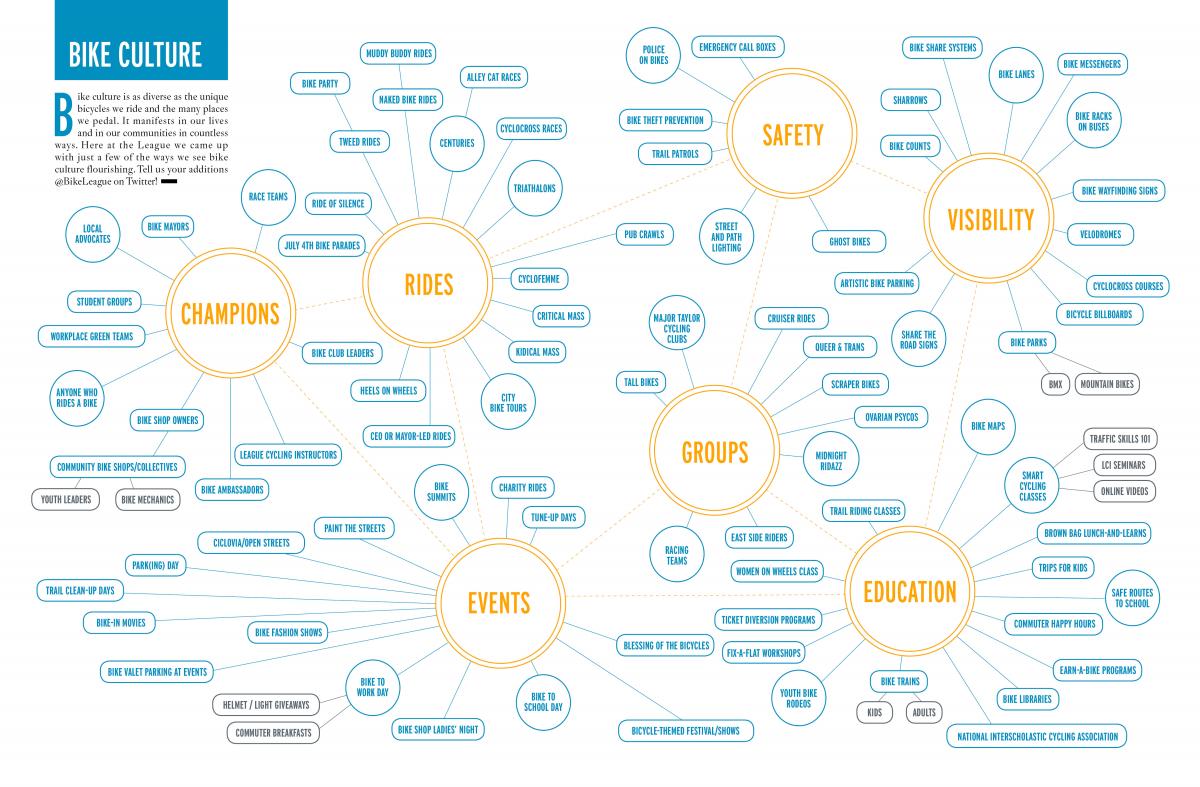DISCOVER YOUR LOCAL BICYCLING COMMUNITY
Find local advocacy groups, bike shops, instructors, clubs, classes and more!
Transportation Culture Clash
This is a story featured in our May-June 2014 American Bicyclist Magazine, which focuses on bike culture. Read the issue here.
Every time I go home to Orange County, California, I go through the same ritual familiar to many of us.
People ask me about my work; I tell them about bikes; they respond with a story about how cyclists are a nuisance, and, while they themselves are too enlightened to menace those bike users, they see others doing it. Therefore, bicycling is a bad idea. I sigh mentally and acquiesce, not because I agree with them, but because I know where they’re coming from. I grew up knowing that driving as soon as I could would be best, because car culture reigns supreme.

Bike Culture infographic – click here to download.
Typically motorists strike two pedestrians each month crossing Pacific Coast Highway in Laguna Beach, a beautiful hillside beach town that would rather you think of its arts festivals rather than its dangerous streets. The PCH is a designated bike route, but in practice people outside of cars don’t matter enough for drivers to be on the lookout. In 2012, the Orange County Register reported, 10 Orange County cities ranked among the worst in California for rates of injuries and fatalities caused by driving under the influence (DUI).
In places where driving is this entrenched, people tell each other that the only safety measure is to simply avoid traveling without the armor of a vehicle.
Most people in Orange County don’t try to challenge the deadliness of car culture by getting out of cars and into streets; they try to get further out of the way. In another Orange County town, San Juan Capistrano, there’s a relatively new pedestrian bridge that funnels people from a parking lot to a high school over a four-lane street. Climbing up and down a flight of stairs seems like a lot more trouble than a crosswalk, but all of this confirms the belief that by remaining in cars or out of their way, you can stay safe.
In this issue of American Bicyclist, we’re calling your attention to culture. Culture is a term that describes the shared systems of meanings and values that regulate our interactions with friends, family, and strangers. Through our cultural work, we show those around us that we “get” it, that we’re complying with the standards they expect from trustworthy individuals. Culture is the interface between an individual and the world that tells her what actions are appropriate and what would deviate from the norm. In any given interaction between road users, who may be using the same streets without the same ideas about what should happen there, cultures can clash. And yet, transportation culture becomes routine and hard to see, especially in places where there’s a very dominant mode.
To recognize transportation culture, start by asking what are our accepted behaviors on roads; what have we agreed upon as uses of shared streets? A few books that consider how we got to where we are today in transportation culture are Peter Norton’s Fighting Traffic and Clay McShane’s Down the Asphalt Path. Can the street on its own transform the stories people tell each other about transportation if cultural norms aren’t taken into account? At dinner tables, over coffee — this is where people tell each other about the right ways to travel.
The way they interact in the street is an outgrowth of a larger mental framework they reinforce through buying bigger and bigger cars at the dealer, talking about bicyclists as a problem, confirming to each other that all the driving is a shame, but there’s no alternative.
Those of us who bike know that’s not the case. With our bodies on our bikes, we map what is possible. We make visible the lines between home, work, shopping, and fun. And in bike shops, co-ops, on rides, in all the places where people talk and wrench and race, bicycling is normal. Spending time in these spaces fuels us and gives us the vocabulary to go tell others about what a great thing biking can be.
We have the opportunity to take more ownership of our role as catalysts for change when we pay attention to our own bike culture. The next time you’re out riding, notice when you feel dismissed or accepted by fellow road users. Are you in a multicultural transportation zone, or in a place where one group’s culture wins?